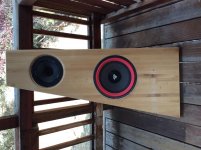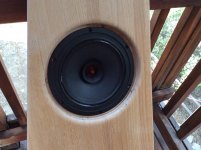Hi folks, I’m Duane and I’m about to put together my first set of open baffle speakers. These will be used mostly for some classic jazz and acoustic guitar music and played at low-medium volume.
Baffles are from an old oak table that’s 1-3/4” thick and it measured 48”x30”. I’ve cut it diagonally and the two pieces are 20” at the base and 10” up top - sort of triangular. I have already cut holes for woofers 18” up from the bottom and chamfered the back sides of the holes with a generous half-round radius. That oak table was a curb find from 30 years ago, BTW, and I’ve wanted to do something fun with it. Now’s the time.
What I’m wanting to do is use a pair of 12” Cerwin-Vega woofers I picked up (also free, off a curb) which I re-foamed, along with a pair of Dayton PS220-8 “point-source” full-range drivers. I was planning on running the PS220 drivers straight from the amp - but limiting the upper response of the 4 ohm Cerwin-Vegas.
Sadly, I don’t have a low power SET or similarly low power SS amp; I’ll be trying these out with an old monster, Krell KSA-100 - until I can pick up something more suitable. Another issue for me is that these speakers will go in front of a large living room with a ceiling peak of 26’. Not sure if that will be a problem. I can get the speakers about 3’ out from the wall without the wife getting too upset.
Can anyone suggest a simple to build low-pass filter that may work OK with the 12” woofers I have and cross smoothly to those Dayton PS220’s?
Thanks for your help. 🙂
Baffles are from an old oak table that’s 1-3/4” thick and it measured 48”x30”. I’ve cut it diagonally and the two pieces are 20” at the base and 10” up top - sort of triangular. I have already cut holes for woofers 18” up from the bottom and chamfered the back sides of the holes with a generous half-round radius. That oak table was a curb find from 30 years ago, BTW, and I’ve wanted to do something fun with it. Now’s the time.
What I’m wanting to do is use a pair of 12” Cerwin-Vega woofers I picked up (also free, off a curb) which I re-foamed, along with a pair of Dayton PS220-8 “point-source” full-range drivers. I was planning on running the PS220 drivers straight from the amp - but limiting the upper response of the 4 ohm Cerwin-Vegas.
Sadly, I don’t have a low power SET or similarly low power SS amp; I’ll be trying these out with an old monster, Krell KSA-100 - until I can pick up something more suitable. Another issue for me is that these speakers will go in front of a large living room with a ceiling peak of 26’. Not sure if that will be a problem. I can get the speakers about 3’ out from the wall without the wife getting too upset.
Can anyone suggest a simple to build low-pass filter that may work OK with the 12” woofers I have and cross smoothly to those Dayton PS220’s?
Thanks for your help. 🙂
Going through this, first order, second order might give you more control, where does the baffle pull down the 8".
The 12" are going to want to be more sensitive than the 8" because they work lower and efficiency down low depends more on the baffle.
You might want to try it first to see what you want to do.
The 12" are going to want to be more sensitive than the 8" because they work lower and efficiency down low depends more on the baffle.
You might want to try it first to see what you want to do.
This will have to be bi-amplified to match the levels. Then you can do the crossover at line level.
Hi Duane,
A 12" is not too much for a large room and will either produce low bass only at very low sensitivity (let´s say around 80dB/2,8V/m) or will produce no bass at all, but therefore decent sensitivity (let´s say around 90dB/2,8V/m, depending on TSP of the driver and your crossover. A PS220 without any correction will not be a good match...
Without some measurements and simulations any attempt to combine your drivers will be guesswork, sorry...
All the best
Mattes
A 12" is not too much for a large room and will either produce low bass only at very low sensitivity (let´s say around 80dB/2,8V/m) or will produce no bass at all, but therefore decent sensitivity (let´s say around 90dB/2,8V/m, depending on TSP of the driver and your crossover. A PS220 without any correction will not be a good match...
Without some measurements and simulations any attempt to combine your drivers will be guesswork, sorry...
All the best
Mattes
Thanks for your replies, guys. Since it looks like the 12’s I have won’t produce the goods in an open baffle, I’ll set those aside for another project. I’m going to save up for 4, 18” woofers and build a box to go behind my baffle - open with two woofers each facing each other and ported to the front. Something like I saw that Mr. Pass had done an article on.
I’ll still use the hole I already cut out and the port will fill that vertically. Once I get the new woofers and do some building, I’ll post pictures.
Thanks again!
I’ll still use the hole I already cut out and the port will fill that vertically. Once I get the new woofers and do some building, I’ll post pictures.
Thanks again!
Forget the hypotheticals and just try it. All hypotheticals are way off once the speaker is in a room. Make a cheap mock-up and run REW (even you laptop mic will be pretty helpful.
B.
B.
18" driver open baffle is similar to a 12" driver on an 18" baffle.
That doesn’t sound too encouraging. I’ll be going with two 15’s or 18’s per side though.
Another question for those who have used them:
Of the large, inexpensive woofers offered by Parts-Express - which actually sound good and make a decent bass response in an OB? Looking at Eminence Alpha, Goldwood, etc. Any preference?
I meant in where the cancellation figures in, not in max output. 😉
<rant>Open baffle is a little like doing a dipole, only freestyle. It kind of opens up the variables and give a certain set of things to discuss</rant>
🙂
<rant>Open baffle is a little like doing a dipole, only freestyle. It kind of opens up the variables and give a certain set of things to discuss</rant>
🙂
here's a start-
open baffles on you tube
The DIY Audio Implementers - YouTube
Martin King
http://www.quarter-wave.com/OBs/OB_Design_Part_1.pdf
http://www.quarter-wave.com/OBs/OB_Design_Part_2.pdf
open baffles on you tube
The DIY Audio Implementers - YouTube
Martin King
http://www.quarter-wave.com/OBs/OB_Design_Part_1.pdf
http://www.quarter-wave.com/OBs/OB_Design_Part_2.pdf
Audio Dandy - How to enjoy High Resolution Audio
Might give you some ideas... There's a schematic for a filter there, which may give you a starting point for a speaker level design. (They show a dual VC driver, but since you're planning on two drivers...) I assume R1 and R2 knock down the FR driver sensitivity to match the woofer.
The Goldwood GW-1858 18" driver might be a good choice for bass duty. A bit less in cost than the Lii 15" bass speaker ;')
Good luck!
Might give you some ideas... There's a schematic for a filter there, which may give you a starting point for a speaker level design. (They show a dual VC driver, but since you're planning on two drivers...) I assume R1 and R2 knock down the FR driver sensitivity to match the woofer.
The Goldwood GW-1858 18" driver might be a good choice for bass duty. A bit less in cost than the Lii 15" bass speaker ;')
Good luck!
I was actually thinking of building this one, too..
Got my driver holes cut. The full-range is recessed 1” to get the voice coil lined up with the leading edge of the woofer’s. I think these may remain “wingless” as the baffle is 1-3/4” thick oak. Edges have all been rounded.
Still haven’t worked out the leg design, but I think it’ll be a single leg, centered on the backside and extending out about 16” and with an adjustable foot to allow for a little tilt back.
I wanted to test it first with the 12” woofer and if I don’t get enough bass, I’ll make changes from there..
Still haven’t worked out the leg design, but I think it’ll be a single leg, centered on the backside and extending out about 16” and with an adjustable foot to allow for a little tilt back.
I wanted to test it first with the 12” woofer and if I don’t get enough bass, I’ll make changes from there..
Attachments
With a panel that narrow, prospects for bass not good unless you make a real deep H.
Many of us really like the way OBs bring music into our rooms. But nothing esp helpful about doing bass that way.
I ran a fine 15-inch woofer in a very large irregular baffle for a while. Nice but not special. Helpful to heterogeneously supplement other subs in the room. What you might gain in room interface you lose in distortion from cone excursion.
BTW, time-aligning the voice coils brings very tiny benefit at low frequencies while recessing the mid-range (in a tunnel!) may well bring damage to the sound.
B.
Many of us really like the way OBs bring music into our rooms. But nothing esp helpful about doing bass that way.
I ran a fine 15-inch woofer in a very large irregular baffle for a while. Nice but not special. Helpful to heterogeneously supplement other subs in the room. What you might gain in room interface you lose in distortion from cone excursion.
BTW, time-aligning the voice coils brings very tiny benefit at low frequencies while recessing the mid-range (in a tunnel!) may well bring damage to the sound.
B.
Last edited:
With a panel that narrow, prospects for bass not good unless you make a real deep H.
Many of us really like the way OBs bring music into our rooms. But nothing esp helpful about doing bass that way.
I ran a fine 15-inch woofer in a very large irregular baffle for a while. Nice but not special. Helpful to heterogeneously supplement other subs in the room. What you might gain in room interface you lose in distortion from cone excursion.
BTW, time-aligning the voice coils brings very tiny benefit at low frequencies while recessing the mid-range (in a tunnel!) may well bring damage to the sound.
B.
Well, that’s what I’m playing with. If I don’t like the sound I’ll make changes or those drivers will go into something else.
Not sure how you can call a well opened, 1” recess a tunnel, BTW.. 🙂
Last edited:
There's the resonance of a pipe, diffraction of edges, and there's messing with the polar dispersion. Not likely easily heard on music, but then time-alignment error in bass certainly not heard on music. All stuff that OCD DIYers fret about when bigger issues are in play.
Did you taper the recess?
B.
Did you taper the recess?
B.
Last edited:
- Home
- Loudspeakers
- Multi-Way
- Please help - low pass filter for open baffle ?


